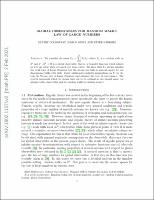Please use this identifier to cite or link to this item:
https://hdl.handle.net/20.500.12202/9582Full metadata record
| DC Field | Value | Language |
|---|---|---|
| dc.contributor.author | Nándori, Péter | - |
| dc.contributor.author | Dolgopyat, Dmitry | - |
| dc.contributor.author | Lenci, Marco | - |
| dc.date.accessioned | 2023-12-04T23:08:53Z | - |
| dc.date.available | 2023-12-04T23:08:53Z | - |
| dc.date.issued | 2021 | - |
| dc.identifier.citation | Dolgopyat, D., Lenci, M., & Nándori, P. (2019). Global observables for random walks: law of large numbers. Annales de l'Institut Henri Poincaré, Probabilités et Statistiques, 57, 1, 94-115, 2021 | en_US |
| dc.identifier.issn | 0246-0203 | - |
| dc.identifier.uri | http://arxiv.org/abs/1902.11071 | en_US |
| dc.identifier.uri | https://hdl.handle.net/20.500.12202/9582 | - |
| dc.description | Scholarly articles / OA (PDF arXiv) | en_US |
| dc.description.abstract | We consider the sums TN=∑Nn=1F(Sn) where Sn is a random walk on Zd and F:Zd→R is a global observable, that is, a bounded function which admits an average value when averaged over large cubes. We show that TN always satisfies the weak Law of Large Numbers but the strong law fails in general except for one dimensional walks with drift. Under additional regularity assumptions on F, we obtain the Strong Law of Large Numbers and estimate the rate of convergence. The growth exponents which we obtain turn out to be optimal in two special cases: for quasiperiodic observables and for random walks in random scenery. Nous considérons la somme TN=∑Nn=1F(Sn) , où Sn est une marche aléatoire à valeurs dans Zd et F:Zd→R est une observable globale, c’est-à-dire une fonction bornée ayant une valeur moyenne sur de grands cubes. Nous montrons que TN satisfait toujours la loi faible des grands nombres mais la loi forte échoue en général, sauf dans le cas de la marche aléatoire unidimensionnelle avec dérive. Sous certaines hypothèses de régularité supplémentaires, nous obtenons la loi forte des grands nombres et nous estimons la vitesse de convergence. Les exposants que nous obtenons sont optimaux dans deux cas particuliers: pour les observables quasi-périodiques et pour les marches aléatoires en paysage aléatoire. | en_US |
| dc.description.sponsorship | Acknowledgements The research of DD was partially sponsored by NSF DMS 1665046. The research of ML was partially supported by PRIN 2017S35EHN (MUR, Italy). The research of PN was partially sponsored by NSF DMS 1800811 and NSF DMS 1952876. | en_US |
| dc.language.iso | en_US | en_US |
| dc.publisher | IMS: Insttiute of Mathematical Statistics | en_US |
| dc.relation.ispartofseries | Annales de l’Institut Henri Poincaré Probab. Statist;57(1) | - |
| dc.rights | Attribution-NonCommercial-NoDerivs 3.0 United States | * |
| dc.rights.uri | http://creativecommons.org/licenses/by-nc-nd/3.0/us/ | * |
| dc.subject | quasiperiodic observables | en_US |
| dc.subject | random walks | en_US |
| dc.title | Global observables for random walks: law of large numbers | en_US |
| dc.type | Article | en_US |
| dc.identifier.doi | https://doi.org/10.1214/20-AIHP1072 | en_US |
| dc.identifier.doi | https://doi.org/10.48550/arXiv.1902.11071 | en_US |
| dc.contributor.orcid | 0000-0001-8238-6653 | en_US |
| local.yu.facultypage | https://sites.google.com/view/peternandori | en_US |
| Appears in Collections: | Stern College for Women -- Faculty Publications | |
Files in This Item:
| File | Description | Size | Format | |
|---|---|---|---|---|
| Nandori 2021 OA arXiv Global observables 1902.11071-1.pdf | 328.65 kB | Adobe PDF |  View/Open |
This item is licensed under a Creative Commons License

